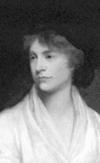- Wollstonecraft, Mary
-
died Sept. 10, 1797, LondonEnglish writer.She taught school and worked as a governess and as a translator for a London publisher. Her early Thoughts on the Education of Daughters (1787) foreshadowed her mature work on the place of women in society, A Vindication of the Rights of Woman (1792), whose core is a plea for equality in the education of men and women. The Vindication is widely regarded as the founding document of modern feminism. In 1797 she married the philosopher William Godwin; she died days after the birth of their daughter, Mary (see Mary Shelley), that same year.
 Mary Wollstonecraft (Godwin), detail, oil on canvas by John Opie, c. 1797; in the National Portrait ...National Portrait Gallery, London
Mary Wollstonecraft (Godwin), detail, oil on canvas by John Opie, c. 1797; in the National Portrait ...National Portrait Gallery, London* * *
▪ English authormarried name Mary Wollstonecraft Godwinborn April 27, 1759, London, Englanddied September 10, 1797, LondonEnglish writer and passionate advocate of educational and social equality for women (women's movement).The daughter of a farmer, Wollstonecraft taught school and worked as a governess, experiences that inspired her views in Thoughts on the Education of Daughters (1787). In 1788 she began working as a translator for the London publisher James Johnson, who published several of her works, including the novel Mary: A Fiction (1788). Her mature work on woman's place in society is A Vindication of the Rights of Woman (1792), which calls for women and men to be educated equally.In 1792 Wollstonecraft left England to observe the French Revolution in Paris, where she lived with an American, Captain Gilbert Imlay. In the spring of 1794 she gave birth to a daughter, Fanny. The following year, distraught over the breakdown of her relationship with Imlay, she attempted suicide.Wollstonecraft returned to London to work again for Johnson and joined the influential radical group that gathered at his home and that included William Godwin (Godwin, William), Thomas Paine (Paine, Thomas), Thomas Holcroft (Holcroft, Thomas), William Blake (Blake, William), and, after 1793, William Wordsworth (Wordsworth, William). In 1796 she began a liaison with Godwin, and on March 29, 1797, Mary being pregnant, they were married. The marriage was happy but brief; Mary Wollstonecraft Godwin died 11 days after the birth of her second daughter, Mary (Shelley, Mary Wollstonecraft).A Vindication of the Rights of Woman is one of the trailblazing works of feminism. Published in 1792, Wollstonecraft's work argued that the educational system of her time deliberately trained women to be frivolous and incapable. She posited that an educational system that allowed girls the same advantages as boys would result in women who would be not only exceptional wives and mothers but also capable workers in many professions. Other early feminists had made similar pleas for improved education for women, but Wollstonecraft's work was unique in suggesting that the betterment of women's status be effected through such political change as the radical reform of national educational systems. Such change, she concluded, would benefit all society.The publication of Vindication caused considerable controversy but failed to bring about any immediate reforms. From the 1840s, however, members of the incipient American and European women's movements resurrected some of the book's principles. It was a particular influence on American women's rights pioneers such as Elizabeth Cady Stanton (Stanton, Elizabeth Cady) and Margaret Fuller (Fuller, Margaret).The life of Mary Wollstonecraft has been the subject of several biographies, beginning with her husband's Memoirs of the Author of A Vindication of the Rights of Woman (1798, reissued 2001, in an edition edited by Pamela Clemit and Gina Luria Walker). Those written in the 19th century tended to emphasize the scandalous aspects of her life and not her work. With the renewed interest in women's rights in the later 20th century, she again became the subject of several books. The Collected Letters of Mary Wollstonecraft, assembled by Janet Todd, was published in 2003.Additional ReadingMoira Ferguson and Janet Todd, Mary Wollstonecraft (1984); Claire Tomalin, The Life and Death of Mary Wollstonecraft, rev. ed. (1992); Janet M. Todd, Mary Wollstonecraft: A Revolutionary Life (2000); Diane Jacobs, Her Own Woman: The Life of Mary Wollstonecraft (2001); and Lyndall Gordon, Vindication: A Life of Mary Wollstonecraft (also published as Mary Wollstonecraft: A New Genus, 2005), cover her life and work. Wil Verhoeven, Gilbert Imlay: Citizen of the World (2008), describes Wollstonecraft's relationship with Imlay. Critical interpretations of Wollstonecraft are presented in Virginia Sapiro, A Vindication of Political Virtue (1992); Syndy McMillen Conger, Mary Wollstonecraft and the Language of Sensibility (1994); Maria J. Falco (ed.), Feminist Interpretations of Mary Wollstonecraft (1996); and Barbara Taylor, Mary Wollstonecraft and the Feminist Imagination (2003).* * *
Universalium. 2010.
